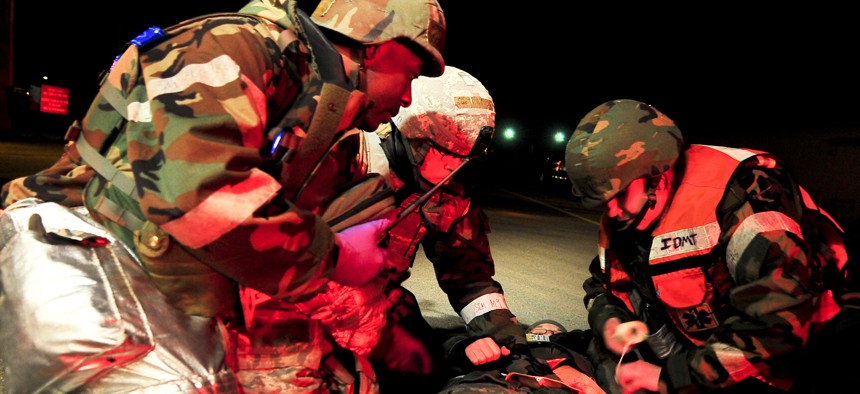
Members of the 51st Civil Engineer Squadron assist a casualty during an active shooter scenario in a 2012 exercise at Osan Air Base, Republic of Korea. U.S. Air Force / Senior Airman Adam Grant
DHS Wants Power-Generating Clothing
The agency wants first responders’ clothing to be able to generate and store electricity.
The Homeland Security Department is looking to outfit first responders with uniforms that can charge radios, sensors and other electronics they carry on the front lines.
The agency’s science and technology office on Tuesday announced a nearly $200,000 contract with Protect the Force, a Boston-based first responder supply company, to develop textiles that can generate and store their own electricity. Firefighters, law enforcement officers and other first responders could ultimately wear the fabric and use it to power their portable devices on the front line.
The award came through the Silicon Valley Innovation Program, an in-house startup accelerator that supports research into emerging national security technologies.
“Protect the Force’s proposed technology could change how first responders are able to perform during emergencies,” said Melissa Ho, managing director of SVIP, in a statement. “A wearable, portable power source could support safety equipment and communication tools; it has the potential to improve the work of first responders across the nation.”
In the first phase of the four-part SVIP accelerator, the company will develop photovoltaic fiber that acts more or less as a solar panel, taking in light and converting it to electricity for later use. DHS plans to eventually weave the fiber into a “power fabric” that would coat first responders’ gear or clothing to provide a constant source of energy.
This marks the first project to receive funding under DHS’ broad other transaction solicitation for “energy harvesting fabrics,” which went live in May 2017. Under the initiative, the agency looks to explore clothing material that can create electricity from heat, sunlight or even the movements of its wearer.
The solicitation specifies three types of clothing DHS would like to research: daily use uniforms worn by police officers, medical personnel and others; wildland firefighter uniforms that can withstand the extreme conditions of wildfires; and structural firefighter gear used when responding to building fires.
“As first responders increase their use of equipment for communications, situational awareness, monitoring and improved technical capabilities, there is an increased requirement for sources of power to operate this equipment,” officials wrote in the modified solicitation. “Since first responders are already carrying a heavy load of required equipment, non-traditional power sources to reduce the logistical and weight burden for responders are required.”




